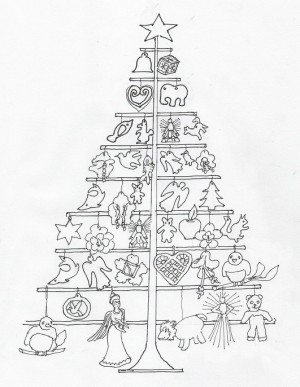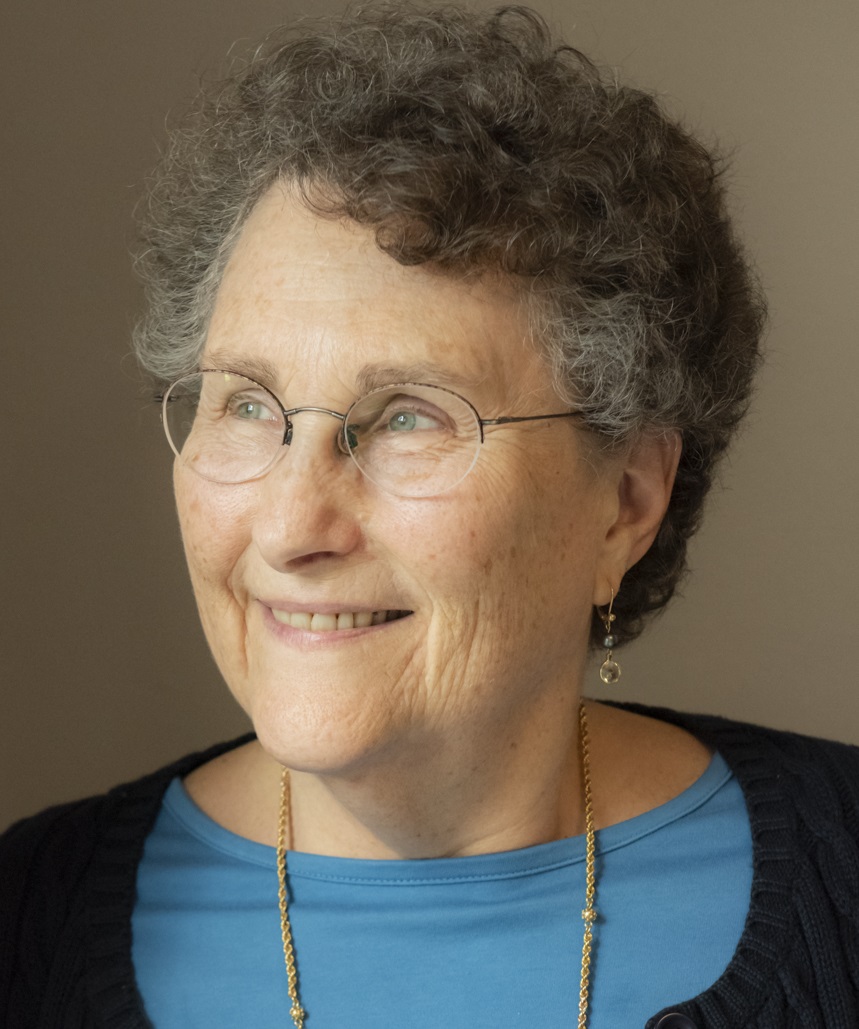Draw near: Praying for joy
Lynne Baab • Tuesday December 13 2022

“These days I find myself curious about what it means to approach joy as a practice, and to receive it as a grace that God offers. . . . I have been pondering how practicing joy involves asking for it, preparing a place for it, praying to be open to it so that we can recognize it when it appears.”
—Jan Richardson, poet, artist, and Methodist minister [1]
Jan Richardson’s words about joy jumped out at me because I don’t do what she suggests. I don’t ask God for joy, prepare a place for it, or ask God that I would be open to it. The concept of joy has always been troubling for me because I have a hard time untangling it from the hyper-optimism I was raised with. The toxic optimism of my childhood feels like a form of severe denial, and I have wanted no part of it.
I suspect that I have engaged so enthusiastically in the practice of thankfulness because it makes an end run around denial to get to joy, even though I have hesitated to use the word “joy” as I think about giving thanks. For me, thankfulness involves noticing gifts in this specific moment and thanking the giver (or Giver), which builds relationship between the giver and recipient. I have never been interested in an “attitude of gratitude” because those words are often connected to optimism. Instead, I want to notice specific gifts and thank the one (or One) who gave that gift to me.
To my daughter-in-law: “These garlic mashed potatoes are amazing. Thanks for taking the extra steps to make them so special.”
To my son: “Thanks for making the trek to Tacoma to pick up Mom for Thanksgiving dinner.”
To my granddaughter: “These place cards are so thoughtful and cute. Thanks for making them for us.”
To my husband: “Thanks for the countless ways you have loved me all year.”
To God: “Thanks for creating turkeys, potatoes, and pumpkins. Thanks for placing me in a family. Thanks for so, so many gifts over the past year.”
You may think I’ve gotten off track about joy, but as I typed all those words that I expressed at Thanksgiving, I felt joy. Thankfulness opens me to joy.
The Psalms mention joy 54 times. (You can read all the verses here.) As I scrolled through the verses where joy is mentioned, I was surprised by how many of those verses I know by heart. One of them highlights the connection between joy and thankfulness: “You show me the path of life. In your presence there is fullness of joy; in your right hand are pleasures for evermore” (Psalm 16:11). In my experience, when we pay attention to the pleasures God gives us and express our thanks, we experience joy in God’s presence.
Here are some other verses about joy in the Psalms, my attempt at a somewhat representative sampling:
“O come, let us sing to the Lord; let us make a joyful noise to the rock of our salvation! Let us come into his presence with thanksgiving; let us make a joyful noise to him with songs of praise!” (Psalm 95:1, 2)
“My soul longs, indeed it faints for the courts of the Lord; my heart and my flesh sing for joy to the living God” (Psalm 84:2).
“Let the field exult, and everything in it. Then shall all the trees of the forest sing for joy” (Psalm 96:12).
“Weeping may linger for the night, but joy comes with the morning” (Psalm 30:5).
The New Testament mentions joy 68 times. (You can read all the verses here.) I am particularly fond of Jesus’ words to his disciples in the Upper Room on the night he was arrested (John 13 to 17), and the word “joy” appears there six times. Jesus describes joy as a result of knowing him:
“I have said these things to you so that my joy may be in you, and that your joy may be complete” (John 15.11).
“So you have pain now; but I will see you again, and your hearts will rejoice, and no one will take your joy from you (John 16:22).
When the Apostle Paul lists the fruit of the Holy Spirit in his letter to the Galatians, joy is the second item on the list (5:22-23). Joy comes from knowing Jesus. Joy comes from being filled with the Holy Spirit. Jesus and Paul seem to emphasize the way joy is a natural outcome of being close to Jesus and allowing the Holy Spirit to work in us.
Maybe you, like me, need to approach joy from the side rather than head on, acknowledging the presence of sorrow and sadness in the world, while also being open to receiving God’s gifts each day. However we approach it, we can expect that joy will be a part of our lives in Christ. Jan Richardson encourages us to expect it, make space for it, and ask God for openness to it. I’ll leave you with her words again, so you can ponder how her ideas might stimulate your prayers.
“These days I find myself curious about what it means to approach joy as a practice, and to receive it as a grace that God offers. . . . I have been pondering how practicing joy involves asking for it, preparing a place for it, praying to be open to it so that we can recognize it when it appears.”
(Next week: The freedom not to have words as we pray. Illustration by Dave Baab. If you’d like to receive an email when I post on this blog, sign up below under “subscribe.”)
Ironically (for someone who has avoided talking or even thinking about joy very often), my book on communal spiritual practices has the title Joy Together. My editor for that book, Jana Riess, came up with the title. She wanted to communicate the deep joy of meeting God together with others.
Related posts:
- Contrasts: thankfulness and optimism
- Joy spot sightings
- Growing in thankfulness (my journey with thankfulness)
- A cat with a noble character
[1] Jan Richardson is quoted in “On Art: Jan Richardson’s That We Might Receive This Joy” in Christian Century, December 2022. Rev. Richardson has created two beautiful self-guided Advent/Christmas retreats filled with art and poetry, downloadable as pdfs from her website: “The Sanctuary Between Us” and “A Path Called Solace.”
Next post »« Previous post
Subscribe to updates
To receive an email alert when a new post is published, simply enter your email address below.

Lynne M. Baab, Ph.D., is a teacher and writer. She has written numerous books, Bible study guides, and articles for magazines and journals. Lynne is passionate about prayer and other ways to draw near to God, and her writing conveys encouragement for readers to be their authentic selves before God. She encourages experimentation and lightness in Christians spiritual practices. Read more »
Lynne is pleased to announce the release of her book on grief and gratitude, designed to help people grieving from anything, including the pandemic, while also desiring to notice God's good gifts. Two Hands: Grief and Gratitude in the Christian Life is available in paperback, audiobook, and for kindle. Lynne's 2018 book is Nurturing Hope: Christian Pastoral Care for the Twenty-First Century, and her best-selling book is Sabbath-Keeping: Finding Freedom in the Rhythms of Rest (now available as an audiobook as well as paperback and kindle). You can see her many other book titles here, along with her Bible study guides.
Lynne recently spoke about empathy and also about bringing spiritual practices to life.
Lynne was interviewed recently for the podcast "As the Crow Flies". The first episode focuses on why listening matters and the second one on listening skills.
Here are two talks Lynne gave on listening (recorded in audio form on YouTube): Listening for Mission and Ministry and Why Listening Matters for Mission and Ministry.
"Lynne's writing is beautiful. Her tone has such a note of hope and excitement about growth. It is gentle and affirming."
— a reader
"Dear Dr. Baab, You changed my life. It is only through God’s gift of the sabbath that I feel in my heart and soul that God loves me apart from anything I do."
— a reader of Sabbath Keeping
Subscribe
To receive an email alert when a new post is published, simply enter your email address below.
Featured posts
- Drawing Near to God with the Heart: first post of a series »
- Quotations I love: Henri Nouwen on being beloved »
- Worshipping God the Creator: the first post of a series »
- Sabbath Keeping a decade later: the first post of a series »
- Benedictine spirituality: the first post of a series »
- Celtic Christianity: the first post of a series »
- Holy Listening »
- A Cat with a Noble Character »
- Welcome to my website »
Tags
Archive
- April 2024 (4)
-
March 2024 (5)
- Friendship, loneliness, and prayer: Praying about distractions from empathy
- Friendship, loneliness, and prayer: Praying to keep empathy flowing
- Friendship, loneliness, and prayer: Everyday initiative
- Friendship, loneliness, and prayer: Praying for guidance for ending conversations
- Friendship, loneliness, and prayer: Reflecting on the series
- February 2024 (4)
- January 2024 (2)
-
December 2023 (6)
- Friendship, loneliness, and prayer: Initiating
- Friendship, loneliness, and prayer: Praying about listening roadblocks
- Friendship, loneliness, and prayer: Praying to love the poverty in our friends
- Friendship, loneliness, and prayer: Praying for “holy curiosity”
- Friendship, loneliness, and prayer: Praying for “holy listening”
- Friendship, loneliness, and prayer: Praying to give affection extravagantly
- November 2023 (4)
-
October 2023 (5)
- Friendship, loneliness and prayer: A listening skill with two purposes
- Friendship, loneliness, and prayer: Saying “thank you” to friends
- Friendship, loneliness, and prayer: One more way reflecting helps us
- Friendship, loneliness, and prayer: Lessons from two periods of loneliness
- Friendship, loneliness, and prayer: Types of reflecting, a listening skill
- September 2023 (4)
- August 2023 (4)
- July 2023 (5)
- June 2023 (3)
- May 2023 (6)
- April 2023 (4)
- March 2023 (4)
- February 2023 (4)
- January 2023 (4)
- December 2022 (5)
- November 2022 (1)
- October 2022 (5)
- September 2022 (5)
-
August 2022 (6)
- Draw near: Confessing sin without wallowing
- Draw near: A favorite prayer about peace, freedom, and much more
- Drawing near with Desmond Tutu: God’s love is the foundation for prayer
- Draw near: Worshipping God with Desmond Tutu
- Draw near: Yearning, beseeching and beholding with Desmond Tutu
- Draw near: Praising God with Desmond Tutu
- July 2022 (2)
- June 2022 (6)
- May 2022 (5)
- April 2022 (6)
- March 2022 (5)
- February 2022 (4)
- January 2022 (3)
- December 2021 (5)
- November 2021 (4)
- October 2021 (5)
- September 2021 (4)
- August 2021 (4)
- July 2021 (4)
- June 2021 (4)
- May 2021 (4)
- April 2021 (5)
- March 2021 (4)
- February 2021 (4)
- January 2021 (4)
- December 2020 (5)
- November 2020 (3)
- October 2020 (5)
- September 2020 (4)
- August 2020 (4)
- July 2020 (5)
- June 2020 (4)
-
May 2020 (4)
- Spiritual diary of sheltering in place: The lifeline of separating thoughts from feelings
- Spiritual diary of sheltering in place: The lifeline of welcoming prayer
- Spiritual diary of sheltering in place: a kite string as a lifeline
- Spiritual diary of sheltering in place: The lifeline of God’s distant future
-
April 2020 (7)
- Spiritual diary of self-isolation: the lifeline of God’s constancy
- Spiritual diary of sheltering in place: The lifeline of accepting my place as a clay jar
- Spiritual diary of sheltering in place: the lifeline of memories
- Spiritual diary of sheltering in place: the lifeline of “Good” in “Good Friday”
- Spiritual diary of sheltering in place: The lifeline of “easier does not mean easy”
- Spiritual diary of sheltering in place: The lifeline of nature
- Spiritual diary of sheltering in place: the lifeline of God’s voice through the Bible
-
March 2020 (7)
- Important anniversaries in 2020: The first Earth Day in 1970
- Important anniversaries in 2020: Florence Nightingale was born in 1820
- Spiritual diary of self-isolation: Weeks 1 and 2
- Spiritual diary of self-isolation: God's grace as a lifeline
- Spiritual diary of self-isolation: The lifeline of limits on thoughts
- Spiritual diary of self-isolation: Wrestling with God for a blessing
- Spiritual diary of self-isolation: responding to terror by listening to Jesus voice
- February 2020 (4)
- January 2020 (5)
- December 2019 (4)
- November 2019 (4)
- October 2019 (5)
- September 2019 (4)
- August 2019 (5)
- July 2019 (4)
- June 2019 (4)
- May 2019 (5)
- April 2019 (4)
- March 2019 (4)
- February 2019 (4)
-
January 2019 (5)
- Nurturing friendships in a cellphone world: Jesus as Friend
- Nurturing friendships in a cellphone world: Friendship with Christ and friendship with others
- Nurturing friendships in a cellphone world: Who is my neighbor?
- Nurturing friendships in a cellphone world: Friendship as action
- Nurturing friendships in a cellphone world: Hymns that describe friendship with God
- December 2018 (3)
-
November 2018 (5)
- Connections between the Bible and prayer: Sensory prayer in Revelation
- First post in a new series: Nurturing friendships in a cellphone world
- Nurturing friendships in a cellphone world: Strong opinions and responses
- Nurturing friendships in a cellphone world: My conversation partners about friendship
- Nurturing friendships in a cellphone world: Two views about communication technologies
- October 2018 (4)
- September 2018 (4)
-
August 2018 (5)
- Providing Christian Care in Our Time
- Providing Christian care in our time: Seven trends in pastoral care today
- Providing Christian Care in Our Time: Skills for Pastoral Care
- Providing Christian care: The importance of spiritual practices
- First post in a new series: Connections between the Bible and prayer
- July 2018 (4)
- June 2018 (4)
- May 2018 (5)
- April 2018 (4)
- March 2018 (5)
- February 2018 (4)
- January 2018 (4)
- December 2017 (5)
- November 2017 (4)
- October 2017 (4)
- September 2017 (5)
- August 2017 (4)
- July 2017 (4)
- June 2017 (4)
-
May 2017 (5)
- My new spiritual practice: Separating thoughts from feelings
- My new spiritual practice: Feeling the feelings
- My new spiritual practice: Coping with feelings that want to dominate
- My new spiritual practice: Dealing with “demonic” thoughts
- My new spiritual practice: Is self-compassion really appropriate for Christians?
- April 2017 (4)
- March 2017 (5)
- February 2017 (4)
- January 2017 (4)
- December 2016 (5)
- November 2016 (4)
- October 2016 (4)
- September 2016 (5)
- August 2016 (4)
- July 2016 (4)
- June 2016 (4)
- May 2016 (5)
- April 2016 (4)
- March 2016 (5)
- February 2016 (4)
- January 2016 (4)
- December 2015 (4)
- November 2015 (4)
- October 2015 (5)
- September 2015 (4)
- August 2015 (4)
- July 2015 (4)
- June 2015 (4)
- May 2015 (4)
- April 2015 (6)
- March 2015 (4)
- February 2015 (4)
- January 2015 (4)
- December 2014 (5)
- November 2014 (4)
- October 2014 (4)
- September 2014 (4)
- August 2014 (5)
- July 2014 (4)
- June 2014 (7)





















